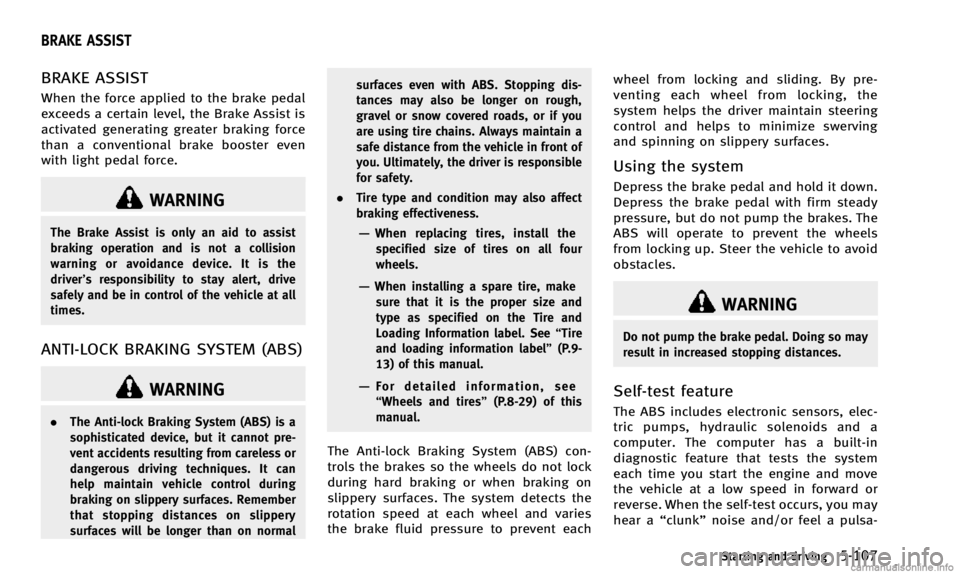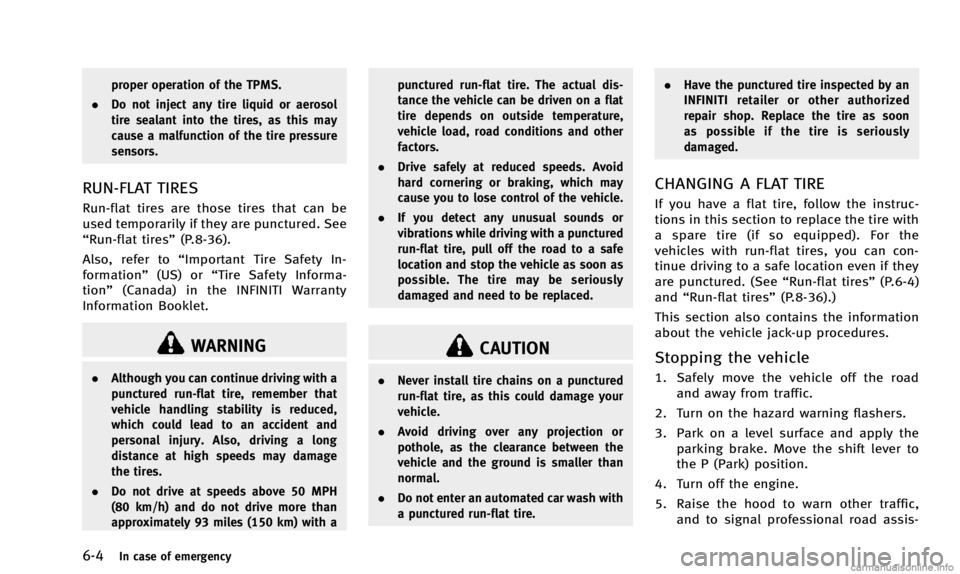brake sensor INFINITI Q50 2014 User Guide
[x] Cancel search | Manufacturer: INFINITI, Model Year: 2014, Model line: Q50, Model: INFINITI Q50 2014Pages: 394, PDF Size: 1.99 MB
Page 282 of 394

BRAKE ASSIST
When the force applied to the brake pedal
exceeds a certain level, the Brake Assist is
activated generating greater braking force
than a conventional brake booster even
with light pedal force.
WARNING
The Brake Assist is only an aid to assist
braking operation and is not a collision
warning or avoidance device. It is the
driver’s responsibility to stay alert, drive
safely and be in control of the vehicle at all
times.
ANTI-LOCK BRAKING SYSTEM (ABS)
WARNING
.The Anti-lock Braking System (ABS) is a
sophisticated device, but it cannot pre-
vent accidents resulting from careless or
dangerous driving techniques. It can
help maintain vehicle control during
braking on slippery surfaces. Remember
that stopping distances on slippery
surfaces will be longer than on normal surfaces even with ABS. Stopping dis-
tances may also be longer on rough,
gravel or snow covered roads, or if you
are using tire chains. Always maintain a
safe distance from the vehicle in front of
you. Ultimately, the driver is responsible
for safety.
. Tire type and condition may also affect
braking effectiveness.
—When replacing tires, install the
specified size of tires on all four
wheels.
—When installing a spare tire, make sure that it is the proper size and
type as specified on the Tire and
Loading Information label. See “Tire
and loading information label” (P.9-
13) of this manual.
—For detailed information, see “Wheels and tires” (P.8-29) of this
manual.
The Anti-lock Braking System (ABS) con-
trols the brakes so the wheels do not lock
during hard braking or when braking on
slippery surfaces. The system detects the
rotation speed at each wheel and varies
the brake fluid pressure to prevent each wheel from locking and sliding. By pre-
venting each wheel from locking, the
system helps the driver maintain steering
control and helps to minimize swerving
and spinning on slippery surfaces.
Using the system
Depress the brake pedal and hold it down.
Depress the brake pedal with firm steady
pressure, but do not pump the brakes. The
ABS will operate to prevent the wheels
from locking up. Steer the vehicle to avoid
obstacles.
WARNING
Do not pump the brake pedal. Doing so may
result in increased stopping distances.
Self-test feature
The ABS includes electronic sensors, elec-
tric pumps, hydraulic solenoids and a
computer. The computer has a built-in
diagnostic feature that tests the system
each time you start the engine and move
the vehicle at a low speed in forward or
reverse. When the self-test occurs, you may
hear a
“clunk” noise and/or feel a pulsa-
Starting and driving5-107
BRAKE ASSIST
Page 283 of 394

5-108Starting and driving
tion in the brake pedal. This is normal and
does not indicate a malfunction. If the
computer senses a malfunction, it switches
the ABS off and illuminates the ABS
warning light on the instrument panel.
The brake system then operates normally,
but without anti-lock assistance.
If the ABS warning light illuminates during
the self-test or while driving, have the
vehicle checked by an INFINITI retailer.
Normal operation
The ABS operates at speeds above 3 to 6
MPH (5 to 10 km/h).
When the ABS senses that one or more
wheels are close to locking up, the actuator
rapidly applies and releases hydraulic
pressure. This action is similar to pumping
the brakes very quickly. You may feel a
pulsation in the brake pedal and hear a
noise from under the hood or feel a
vibration from the actuator when it is
operating. This is normal and indicates
that the ABS is operating properly. How-
ever, the pulsation may indicate that road
conditions are hazardous and extra care is
required while driving.The Vehicle Dynamic Control (VDC) system
uses various sensors to monitor driver
inputs and vehicle motion. Under certain
driving conditions, the VDC system helps
to perform the following functions.
.
Controls brake pressure to reduce
wheel slip on one slipping drive wheel
so power is transferred to a non
slipping drive wheel on the same axle.
. Controls brake pressure and engine
output to reduce drive wheel slip based
on vehicle speed (traction control func-
tion).
. Controls brake pressure at individual
wheels and engine output to help the
driver maintain control of the vehicle in
the following conditions:
— understeer (vehicle tends to not
follow the steered path despite
increased steering input)
— oversteer (vehicle tends to spin due
to certain road or driving condi-
tions).
The VDC system can help the driver to
maintain control of the vehicle, but it
cannot prevent loss of vehicle control in
all driving situations.
When the VDC system operates, the VDC
warning light
in the instrument panel flashes so note the following:
.
The road may be slippery or the system
may determine some action is required
to help keep the vehicle on the steered
path.
. You may feel a pulsation in the brake
pedal and hear a noise or vibration
from under the hood. This is normal
and indicates that the VDC system is
working properly.
. Adjust your speed and driving to the
road conditions.
See “Vehicle Dynamic Control (VDC) warn-
ing light” (P.2-17).
If a malfunction occurs in the system, the
VDC warning light
illuminates in the
instrument panel. The VDC system auto-
matically turns off.
The VDC OFF switch is used to turn off the
VDC system. The VDC off indicator light
illuminates to indicate the VDC system is
off. When the VDC switch is used to turn off
the system, the VDC system still operates
to prevent one drive wheel from slipping by
transferring power to a non slipping drive
wheel. The VDC warning light
flashes if
this occurs. All other VDC functions are off,
except for brake force distribution, and the
VDC warning light
will not flash. The
VEHICLE DYNAMIC CONTROL (VDC) SYSTEM
Page 295 of 394

6-4In case of emergency
proper operation of the TPMS.
. Do not inject any tire liquid or aerosol
tire sealant into the tires, as this may
cause a malfunction of the tire pressure
sensors.
RUN-FLAT TIRES
Run-flat tires are those tires that can be
used temporarily if they are punctured. See
“Run-flat tires” (P.8-36).
Also, refer to “Important Tire Safety In-
formation” (US) or“Tire Safety Informa-
tion” (Canada) in the INFINITI Warranty
Information Booklet.
WARNING
. Although you can continue driving with a
punctured run-flat tire, remember that
vehicle handling stability is reduced,
which could lead to an accident and
personal injury. Also, driving a long
distance at high speeds may damage
the tires.
. Do not drive at speeds above 50 MPH
(80 km/h) and do not drive more than
approximately 93 miles (150 km) with a punctured run-flat tire. The actual dis-
tance the vehicle can be driven on a flat
tire depends on outside temperature,
vehicle load, road conditions and other
factors.
. Drive safely at reduced speeds. Avoid
hard cornering or braking, which may
cause you to lose control of the vehicle.
. If you detect any unusual sounds or
vibrations while driving with a punctured
run-flat tire, pull off the road to a safe
location and stop the vehicle as soon as
possible. The tire may be seriously
damaged and need to be replaced.
CAUTION
.Never install tire chains on a punctured
run-flat tire, as this could damage your
vehicle.
. Avoid driving over any projection or
pothole, as the clearance between the
vehicle and the ground is smaller than
normal.
. Do not enter an automated car wash with
a punctured run-flat tire. .
Have the punctured tire inspected by an
INFINITI retailer or other authorized
repair shop. Replace the tire as soon
as possible if the tire is seriously
damaged.
CHANGING A FLAT TIRE
If you have a flat tire, follow the instruc-
tions in this section to replace the tire with
a spare tire (if so equipped). For the
vehicles with run-flat tires, you can con-
tinue driving to a safe location even if they
are punctured. (See “Run-flat tires”(P.6-4)
and “Run-flat tires” (P.8-36).)
This section also contains the information
about the vehicle jack-up procedures.
Stopping the vehicle
1. Safely move the vehicle off the road and away from traffic.
2. Turn on the hazard warning flashers.
3. Park on a level surface and apply the parking brake. Move the shift lever to
the P (Park) position.
4. Turn off the engine.
5. Raise the hood to warn other traffic, and to signal professional road assis-
Page 388 of 394

OilCapacities and
recommended fuel/lubricants ........................ 9-2
Changing engine oil and filter ...................... 8-10
Checking engine oil level ............................. 8-10
Engine oil .................................................... 8-10
Engine oil viscosity ........................................ 9-7
One touch unlock sensor (See Intelligent
Key system) ........................................................ 3-9
Operation Indicators for operation ............................... 2-22
Outside air temperature .................................... 2-30
Outside mirrors ................................................. 3-27
Overheat, If your vehicle overheats ................... 6-12
Owner’s Manual/Service Manual
order information .............................................. 9-23
P
Panic alarm ...................................................... 3-16
Parking Parking brake operation ............................... 5-20
Parking on hills ......................................... 5-103
Parking brake break-in .................................... 5-106
Personal lights .................................................. 2-54
PERSONAL mode ............................................... 5-23
Phone
Car phone or CB radio ................................... 4-3
Power Power door lock ............................................. 3-4
Power outlet ................................................ 2-44
Power steering fluid ..................................... 8-13 Power steering system ............................... 5-104
Power windows ............................................ 2-49
Precautions Braking precautions ................................... 5-106
Child restraints ............................................ 1-24
Cruise control .............................................. 5-56
Maintenance .................................................. 8-5
Seat belt usage ........................................... 1-12Supplemental restraint system ..................... 1-42
When starting and driving .............................. 5-3
Pre-crash seat belts with comfort function ........ 1-14
Predictive forward collision warning system ...... 5-94
Push starting .................................................... 6-11
Push-button ignition switch .............................. 5-10
R
Radio Car phone or CB radio ................................... 4-3
Rain-sensing auto wiper system ........................ 2-35
Rapid air pressure loss ....................................... 5-9
Readiness for inspection/maintenance (I/M) test
(US only) .......................................................... 9-22 Rear door lock Child safety rear door lock ............................. 3-6
Rear seats .......................................................... 1-5
Rear window and outside mirror
defroster switch ................................................ 2-36
Recorders Event data ................................................... 9-23
Registering your vehicle in another country ...... 9-11
Remote keyless entry system ............................ 3-14 Reporting safety defects ................................... 9-21
Request switch (See Intelligent Key system) ........ 3-9
Roadside assistance program ............................. 6-2
Rollover .............................................................. 5-8
Roof
Moonroof ..................................................... 2-52
Run-flat tires ....................................................... 6-4
S
Safety
Child seat belts ........................................... 1-22
Reporting safety defects .............................. 9-21
Seat adjustment Front power seat adjustment .......................... 1-3
Front seats ..................................................... 1-3
Seat belt(s) Child safety ................................................. 1-22
Infants ......................................................... 1-23
Injured persons ........................................... 1-14Larger children ............................................. 1-23
Precautions on seat belt usage .................... 1-12
Pre-crash seat belts with comfort function ... 1-14 Pregnant women .......................................... 1-14
Seat belt cleaning .......................................... 7-7
Seat belt extenders ...................................... 1-21
Seat belt maintenance ................................. 1-21
Seat belt warning light and chime ............... 2-16
Seat belts .................................................... 1-12
Seat belts with pretensioners ...................... 1-54
Shoulder belt height adjustment .................. 1-20
Small children ............................................. 1-23
10-5